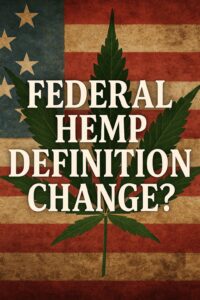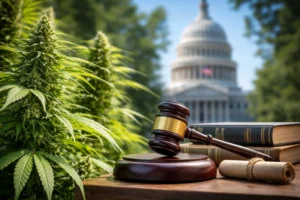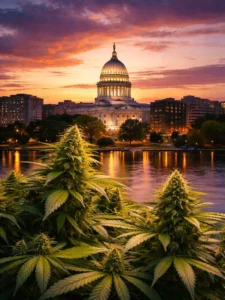Hemp Redefinition 2025 – it seems on the federal agenda with the budget or the new Farm Bill. The 2018 Farm Bill opened a hemp flood-gate nobody in D.C. fully understood—especially once chemists discovered Delta-8, THCA flower, and every alphabet cannabinoid in between. Seven years later, Congress is trying to shove the genie back in the bottle with Section 781 of the Senate FY-2026 Agriculture–FDA appropriations bill, S. 2256.
*The House uses different section numbers, but the substance is nearly identical. Read the Language that Rand Paul objected to right here: LINK.
Why This Isn’t Settled Law—Yet

-
McConnell wants a clamp-down: a total-THC standard (0.3 % including THCA) and an outright ban on synthetic or “converted” cannabinoids.
-
Paul says that goes too far, calling it “prohibition wrapped in consumer-safety gift paper.” He’s pushing carve-outs for low-dose beverages, full-spectrum CBD, and seed sales.
Until those opposing views reconcile, the language remains in flux. Expect high-stakes edits right up to the fall conference committee.
What Section 781 Currently Demands
-
New Hemp Definition – Hemp would be Cannabis sativa L. with ≤ 0.3 % total THC (THCA counted).
-
Industrial-Hemp Safe Harbor – Fiber, grain, and micro-greens stay legal; Congress wants to protect rope and textiles, not intoxicants.
-
Explicit Exclusions – Out go lab-only cannabinoids (THCO, THCP), CBD-to-Delta-8 conversions, and any product with “quantifiable amounts” of THC or THCA.
-
One-Year Fuse – The rules activate no sooner than twelve months after enactment—one growing season to pivot.
-
FDA/USDA Report – Within six months of passage, regulators must propose uniform labeling, testing, and adverse-event rules.
The Flash Point: “Quantifiable THC”
The bill never says what quantifiable means. Set it at 0 mg and every full-spectrum tincture dies. Peg it at 2 mg per serving and the beverage sector limps on. McConnell has been silent on numbers; Paul openly argues the cap should reflect real-world consumer safety data, not detection-limit perfectionism.
Kentucky’s Hemp Politics Drive the Fight
Kentucky growers pivoted to smokable flower and Delta-8 just to survive plummeting CBD prices. McConnell hears from law enforcement tired of under-21 vape sales; Paul hears from hemp processors staring at bankruptcy if total-THC equals zero. Neither senator can afford to look anti-farmer, yet their definitions of “farmer” differ sharply:
-
McConnell’s farmer: fields of fiber, bags of grain, zero buzz.
-
Paul’s farmer: value-added cannabinoids that compete with cannabis MSOs across state lines.
What Businesses Should Do Now
-
Audit COAs – If your flower or extract exceeds 0.3 % total THC, assume it will be illegal by late 2026 unless Paul prevails.
-
Reformulate SKUs – Start R&D on ≤ 2 mg THC beverages and gummies; even Paul’s compromise won’t save 25 % THCA buds.
-
Diversify Genetics – Lock in fiber- or grain-dominant cultivars; demand for hurd, seed oil, and bast fiber will spike if the cannabinoid market shrinks.
-
Engage Politically – Whatever side you take, get your comments ready for the FDA docket. The definition of quantifiable will likely be set there, not on the Senate floor.
-
Plan for Patchwork – States won’t wait for Congress. If you sell across borders, track state limits that may arrive sooner—and be stricter.
Timeline to Watch
-
August recess: Senate staff draft compromise language.
-
September-October: House–Senate conference tries to reconcile differences.
-
November-December: Final bill could hitch a ride on an omnibus or a continuing resolution.
-
2026 Q4 (at the earliest): New rules begin—unless litigation slows enforcement.
Final Thoughts
Section 781 isn’t a blanket “hemp ban”; it’s a fork in the road. One path leaves a tiny, de-intoxicated hemp sector and funnels everything else into state-legal marijuana systems. The other path keeps a federally lawful, low-dose cannabinoid market alive—so long as products stay under a yet-to-be-defined “quantifiable” ceiling.
Until McConnell and Paul find common ground, bet on uncertainty. Use this window to clean up supply chains, document testing protocols, and—above all—stay nimble. History shows Congress rarely gets hemp right on the first try, but it always makes a market pick a side.
Need a compliance game-plan? Reach out before “quantifiable THC” becomes more than just a line in a bill and the Hemp Redefinition 2025 is a real thing.




